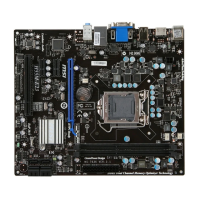En-31
MS-7636 Mainboard
English
CH1/ CH2 tRTP
Time interval between a read and a precharge command.
CH1/ CH2 tFAW
This item is used to set the tFAW timing.
Current CH1/ CH2 tdrRdTRd/ tddRdTRd/ tsrRdTWr/ tdrRdTWr/ tddRdTWr/
tsrWrTRd/ tddWrTWr/ tsrRDTRd/ tsrWrTWr
These item show the advanced DRAM timings.
Channel 1/ Channel2 Advanced Memory Setting
Setting to [Auto] enables the advance memory timing automatically to be determined
by BIOS. Setting to [Manual] allows you to set the following advanced memory tim-
ings.
Memory Ratio
This item allows you to set the memory multiplier.
Adjusted DRAM Frequency (MHz)
It shows the adjusted DRAM frequency. Read-only.
QPI Ratio
This item allows you to set the QPI multiplier.
Adjusted QPI Frequency (MHz)
It shows the adjusted QPI frequency. Read-only.
Auto Disable PCI Frequency
When set to [Enabled], the system will remove (turn o) clocks from empty PCI slots to
minimize the electromagnetic interference (EMI).
DRAM Voltage (V)
These items are used to adjust the voltage of Memory.
Spread Spectrum
When the mainboard’s clock generator pulses, the extreme values (spikes) of the pulses
create EMI (Electromagnetic Interference). The Spread Spectrum function reduces the
EMI generated by modulating the pulses so that the spikes of the pulses are reduced
to atter curves.
Important
If you do not have any EMI problem, leave the setting at [Disabled] for optimal system
stability and performance. But if you are plagued by EMI, select the value of Spread
Spectrum for EMI reduction.
The greater the Spread Spectrum value is, the greater the EMI is reduced, and the
system will become less stable. For the most suitable Spread Spectrum value, please
consult your local EMI regulation.
Remember to disable Spread Spectrum if you are overclocking because even a slight
jitter can introduce a temporary boost in clock speed which may just cause your over-
clocked processor to lock up.
▶
▶
▶
▶
▶
▶
▶
▶
▶
▶
▶
•
•
•

